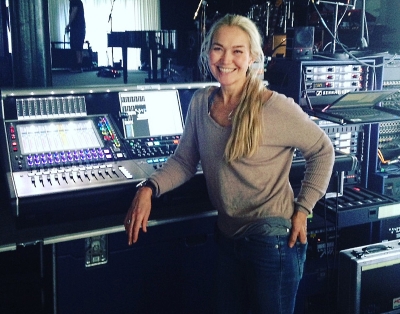For three years now I’ve been in the privileged position of taking care of monitors across an array of different festivals, including the “Pyramid” main stage at the world’s largest greenfield festival, Glastonbury, based in Somerset, England. Working for long-standing suppliers to the festival and one of the oldest sound companies in the world, RG Jones Sound Engineering, I spend about 10 days on site preparing for the three show days.
It’s always an enriching experience, albeit one that requires a lot of hard work, concentration and a high tolerance for mud. RG Jones was invited to provide its magic formula to the iconic Pyramid Stage in 2008 and have been invited to return to the site every performance since, now covering three of the main stages across the festival – Pyramid, West Holts and Block 9.
Each year we play host to some of the world’s biggest bands and artists, and around 100,000 people gather to watch the headliner each night. Oh, and it’s broadcast live. No pressure…

I’ll admit that when I was first offered the gig, I was slightly daunted – it’s a big deal, and it was a lot of responsibility. Although I had many years of large-scale touring experience under my belt, keeping one band happy is a different skill set from coordinating 24 different bands over a 3-day festival; but I do know that two of my strengths are being organized and being able to stay calm under pressure, so I said yes.
I was honored to be invited to take care of this iconic event and had a blast. Three years on, I’ve got a few tips up my sleeve for running monitors on any festival or multi-band event, and I’ll share some of them with you here – I hope you find them helpful.
Hit The Ground Running
The three master keys to this job are in the title of this article: organization, communication, anticipation. There’s very little margin for error at Glasto – we have eight bands per day on the Pyramid, and changeovers might be as short as 20 minutes, so everyone’s got to be totally on the ball.
The groundwork starts months before we get anywhere near site; RG Jones works with key members of the crew to collect tech riders, stage plots, desk files and input lists from bands, and cross-referencing them with the other engineers to make sure we’ve got the correct version. We need to know who’s bringing all their own monitor gear; who’s bringing their own desk but needs the house wedges/in-ear monitors/side fills/line system; who’s coming with an engineer but no gear; who’s turning up with no engineer (in which case I or my fellow house engineer will mix them), and so on.
Further, who needs what kind of power? Who’s bringing their own RF? They’ll need to coordinate with whoever is managing radios – in the case of Glasto, we bring in the big guns and have the UK governing body (named Ofcom) take care of all of the frequency coordination and licensing requirements, but on a small festival, it might be down to you.
Some bands will be forthcoming early on with this stuff, while others need chasing almost until show day. Frequently there will be some changes once they get to the site despite our best efforts, so we have be ready to adapt.
No Stone Unturned
Then there’s the logistics of space. Hopefully, there’s a good stage manager looking after rolling riser movements, and you’ll coordinate with them to decide on stage left space allocation. It can get pretty crowded if several bands have their own desks.
At Glasto, we have two house desks that are on rolling risers. Typically the headliner will load in overnight and be set furthest back, then we’ll wheel in the house desks in front of them, along with other guest desks as appropriate. As the day goes on and the bands get bigger and more self-contained, when the house desks are no longer needed we can get them out of the way.
Communication is absolutely vital on any gig, and never more so than on a festival. Carefully consider and plan your shout systems. Think about how your patch and stage techs are going to communicate with you, front of house and (if it’s going live) the broadcast truck – radio mics with push-to-talk switches and IEMs, or a radio comms headset system that can also be patched into the shout systems are options.














